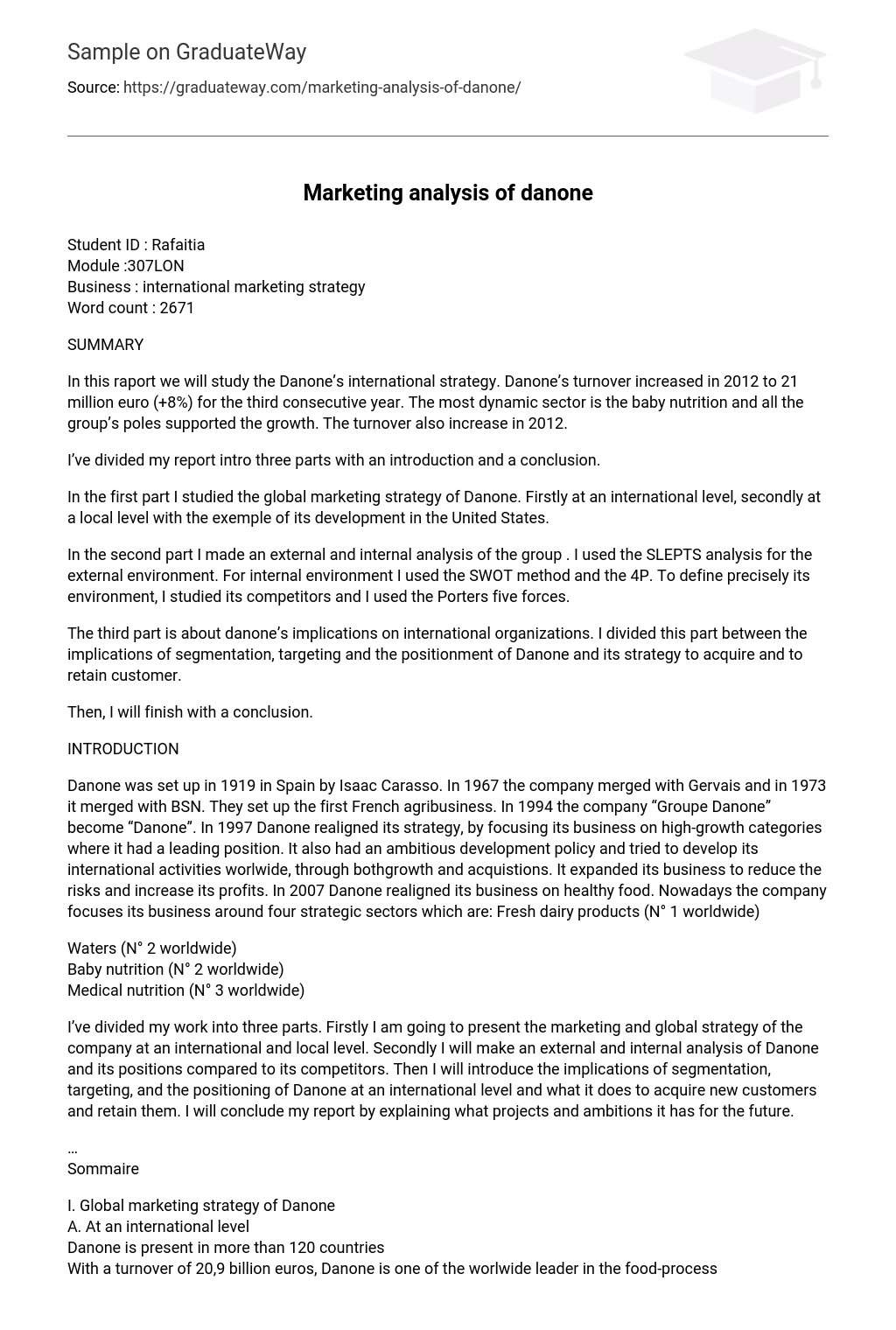INTRODUCTION
Danone was set up in 1919 in Spain by Isaac Carasso. In 1967 the company merged with Gervais and in 1973 it merged with BSN. They set up the first French agribusiness. In 1994 the company “Groupe Danone” become “Danone”. In 1997 Danone realigned its strategy, by focusing its business on high-growth categories where it had a leading position. It also had an ambitious development policy and tried to develop its international activities worlwide, through bothgrowth and acquistions. It expanded its business to reduce the risks and increase its profits. In 2007 Danone realigned its business on healthy food. Nowadays the company focuses its business around four strategic sectors which are: Fresh dairy products
- (N° 1 worldwide)
- Waters (N° 2 worldwide)
- Baby nutrition (N° 2 worldwide)
- Medical nutrition (N° 3 worldwide)
I’ve divided my work into three parts. Firstly I am going to present the marketing and global strategy of the company at an international and local level. Secondly I will make an external and internal analysis of Danone and its positions compared to its competitors. Then I will introduce the implications of segmentation, targeting, and the positioning of Danone at an international level and what it does to acquire new customers and retain them. I will conclude my report by explaining what projects and ambitions it has for the future.
Global marketing strategy of Danone
At an international level. Danone is present in more than 120 countries. With a turnover of 20,9 billion euros, Danone is one of the worlwide leader in the food-processing industry. In 2012, 60% of sales were in international market, in emerging and high growth countries. Only 40% of sales were in Europe. Europe no longer produces the highest part of its turnover. The company is present in four sectors:
- Fresh dairy products
- Baby nutrition
- Waters
- Medical nutrition
To differenciate itself and enhance its positions Danone follows its strategy of growth by innovation. Its commitment is to growth and to strengthing the health aspect of its brand awareness. To release its goal Danone invests heavily in research and development, approximately € 190 million in 2007. 100% of the proposed projects are dedicated to health and nutrition.
The company has launched a lot of products in each of its activity. Moreover it multiplies product differentiation in various geographical areas by adapting them to the specificity of local demand. The global strategy of Danone is to focus on health and nutrition and indeed it is one of the few agribusinesses group totally centred on the health
At a local level. With a workforce reaching 2086 employees and a plant production of 9 firms, the United States is one of the most important markets of Danone. The United States has now became one of its largest markets (8% turnover). The group is present in three sectors in United States: dairy products (Activia, Oikos, Light & Fit, Danimals), medical nutrition (Neocate, Lophlex, Pro-stat, Periflex, KetoCal, Nutrison, FrotiFit) and waters (Evian, volvic, Badoit, Bonafont).
In 2012 the group launched a greek yogurt with its brand Oikos. According to Danone’s consumer and market research, Danone based its strategy on “fight againt obesity”. Consumers were alerted to the fact that they needed a healty diet and the number of yogurts bought rise from 9% in 2010 to 47%. This growth based on household consumption remains the main driver of economical activity.
Conclusion
Danone has developed its business internationally especially in economically emerging countries and has focused its brand awareness on health and well-being. It has established its strategy around 5 mains factors. Danone’s growth :





